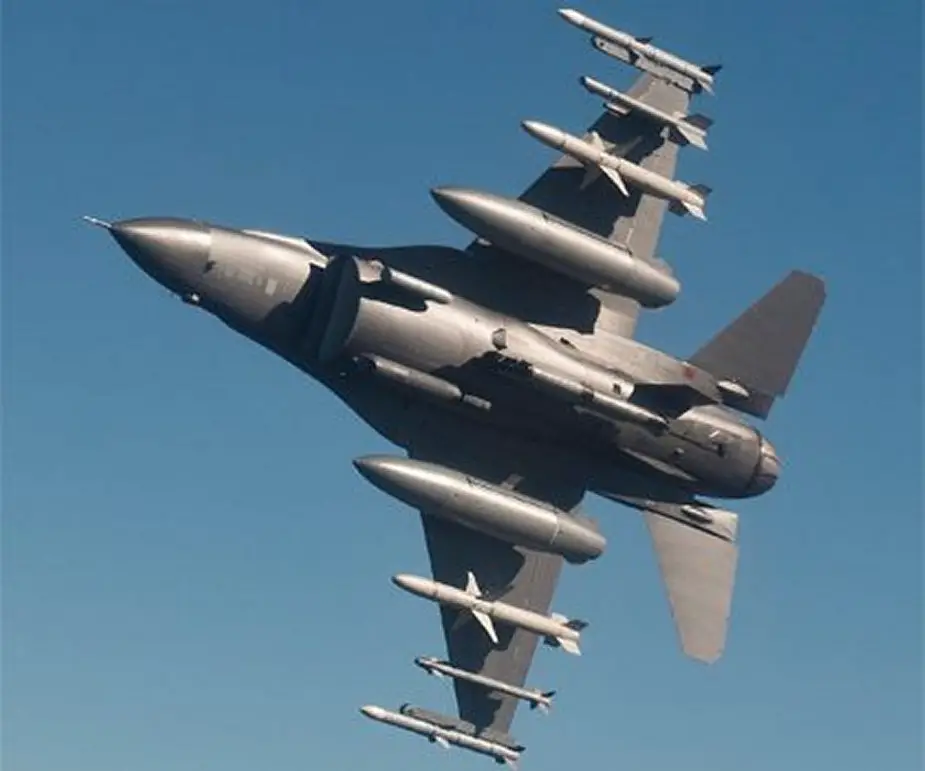As announced on 16 October 2015 by George Standridge, Lockheed Martin Aeronautics' vice president of business development,Lockheed Martin will now produce its F-16 Fighting Falcon exclusively to the V, or Viper, standard, in order to simplify manufacture and orders, especially for international customers, Caleb Larson reports on The National Interest.
Follow Air Recognition on Google News at this link

Lockheed Martin F-16 V "Viper" fully armed (Picture source : Lockheed Martin)
Over 3,000 F-16s are in service today with 25 countries. The F-16 V known as the Viper will become the base F-16 model proposed to all potential customers. In addition to a reduced radar cross-section, Lockheed Martin claims that the Viper’s estimated structural life is 50% greater than previous F-16s. Potential future customers may formulate other equipment requests on top of the F-16V base.

Lockheed Martin F-16 V "Viper" (Picture source : Lockheed Martin)
F-16V "Viper"
The F-16V is the most technologically advanced 4th generation fighter in the world. The F-16V configuration includes numerous enhancements designed to keep the F-16 at the forefront of international security, strengthening its position as the world’s foremost combat-proven 4th Generation multi-role fighter aircraft. The F-16V provides advanced combat capabilities in a scalable and affordable package. The core of the F-16V configuration is an Active Electronically Scanned Array (AESA) radar, a modern commercial off-the-shelf (COTS)-based avionics subsystem, a large-format, high-resolution display; and a high-volume, high-speed data bus. Operational capabilities are enhanced through a Link-16 Theater Data Link, Sniper Advanced Targeting Pod, advanced weapons, precision GPS navigation, and the Automatic Ground Collision Avoidance System (Auto GCAS).
Northrop Grumman’s advanced APG-83 AESA radar delivers greater situational awareness, flexibility and quicker all-weather targeting. The APG-83 provides pilots with unprecedented target area detail and digital map displays that can be tailored with slew and zoom features. The APG-83 provides F-16s with 5th Generation fighter radar capabilities by leveraging hardware and software commonality with F-22 and F-35 AESA radars. The APG-83 AESA radar enables greater detection and tracking ranges, multiple target track (20-plus target tracks), high-resolution Synthetic Aperture Radar (SAR) maps for all-environment precision strike, interleaved air-to-air and air-to-surface mode operations for improved situational awareness, operational effectiveness and survivability; and robust electronic protection for operations in dense radio frequency (RF) environments. The APG-83 also provides greater overall system reliability and availability—three to five times that of legacy MSCAN radars.
Another key feature of the F-16V configuration is the new Center Pedestal Display (CPD), which provides critical tactical imagery to pilots on a high-resolution 6”x 8” screen. The high-resolution display allows Pilot to take full advantage of AESA and Targeting Pod data. The new CPD enables color moving maps, larger and easier to manage air-to-air Situation Displays, zoom functionality with the ability to switch information among displays, and digital display of Flight Instrument Data. The CPD is also compatible with the Night Vision Imaging System (NVIS).
On 15 February 2012, Lockheed Martin unveiled a new version of their F-16 at the 2012 Singapore Airshow. The F-16V features enhancements including an AN/APG-83 active electronically scanned array (AESA) radar, an upgraded mission computer and architecture, and improvements to the cockpit – all capabilities identified by the U.S. Air Force and several international customers for future improvements. The new variant is dubbed the "Viper", which is intended to better operate with fifth-generation fighters, and should not be confused with Lockheed's F-16IN Block 70/72 "Super Viper", which was offered to India for the Medium Multi-Role Combat Aircraft competition and showcased at the 2009 Aero India Air Show. "The new F-16V becomes the new F-16 baseline. On 16 October 2015, the F-16V flew for the first time with an APG-83 Scalable Agile Beam Radar AESA, a new Center Pedestal Display, a modernized mission computer, Automatic Ground Collision Avoidance System, and many other upgrades. This can be fitted on new production F-16s or retrofitted on existing ones. The first of these were for Taiwan F-16A/B Block 20s. The upgrade of its 144 aircraft fleet started in January 2017 and is expected to complete by 2023.
In September 2017, the US State Department approved a Foreign Military Sale to Bahrain for 19 new F-16V and upgrade its 20 existing F-16 block 40 to F-16V. In October 2017, the US approved the sale of 123 upgrade kits to Greece to bring their existing F-16C and D fighters up to the new F-16V standard. On 28 April 2018, Greece decided to upgrade 85 aircraft. South Korea also plans to upgrade 134 of its F-16 fleet to F-16V by November 2025.
In April 2018, the U.S. State Department approved a Foreign Military Sale to Slovakia for 14 new F-16Vs, pending approval from U.S. Congress. The Defence Ministry of Slovakia announced on 11 July 2018 that it intended to purchase 14 F-16 Block 70 aircraft from Lockheed Martin to replace its aging fleet of MiG-29s. The package, which includes armament and training, is worth €1.58 billion ($1.8 billion), and is Slovakia's largest military purchase in modern history. Defence Minister Peter Gajdoš signed the contract with Lockheed Martin representative Ana Wugofski in a press conference at the capital Bratislava on 12 December 201,] after the government approved the purchase. In June 2018, Bahrain finalized its order for 16 brand new Block 70 F-16V. In December 2018, Bulgaria chose eight F-16Vs as replacements for MiG-29s.] On 10 July 2019, Bulgaria approved the purchase of eight F-16V Block 70/72 for $1.25 billion.
On 27 February 2019, Taiwan requested to buy 66 new F-16V Block 70/72 airframes for an approximate $13 billion as replacement for their aging Mirage 2000 and F-5 fighters. On 16 August 2019, the US State Department submitted the package to Congress, total package worth $8 billion for 66 F-16 Block 70 and other spare parts. On 13 December 2019, the U.S. and Taiwan finalized the F-16V order. On 14 August 2020, Taiwan formally signed an agreement to buy 66 F-16V jets built by Lockheed Martin.
















